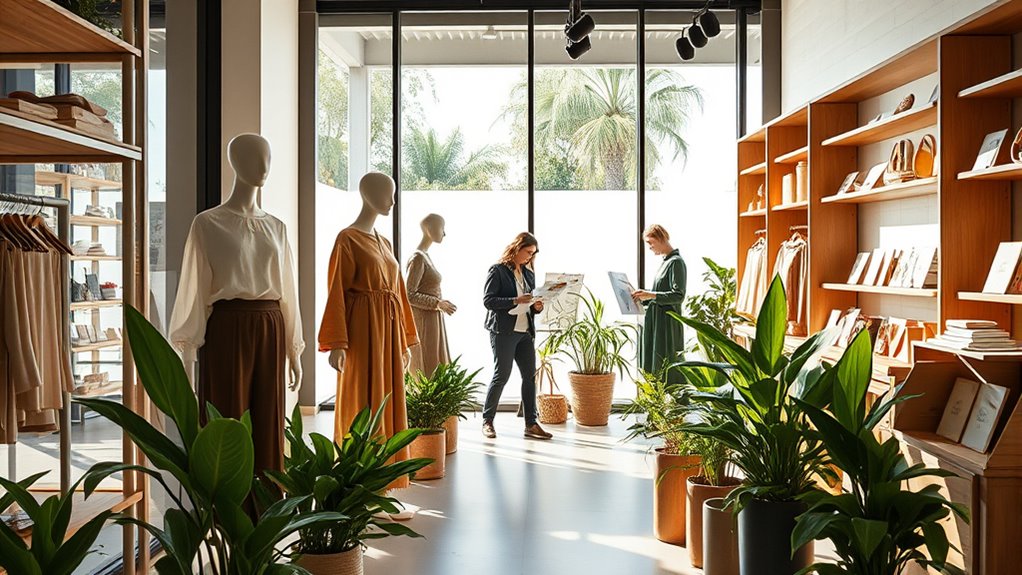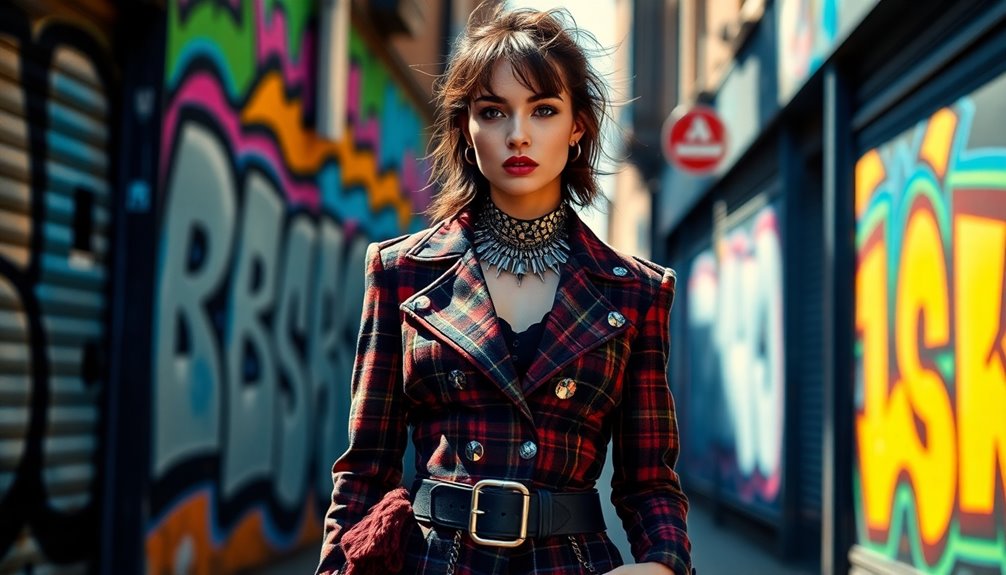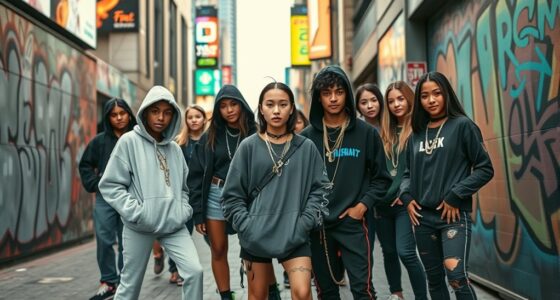Luxury fashion brands are actively working toward sustainability by joining industry-wide initiatives, setting ambitious environmental targets, and adopting eco-friendly materials like plant-based leathers and recycled fabrics. They focus on transparency, reducing emissions, and creating timeless designs that last. Pioneers like Gucci, Stella McCartney, and Gabriela Hearst lead with innovative solutions and ethical practices. If you want to explore how these brands are shaping eco-conscious fashion, keep exploring the latest efforts and strategies.
Key Takeaways
- Luxury brands are adopting sustainable materials like plant-based leathers, recycled nylons, and natural fibers to create eco-friendly products.
- Industry alliances such as The Fashion Pact aim for net-zero emissions and increased renewable energy use by 2025-2050.
- Leading brands set long-term sustainability goals, including reducing carbon footprints and increasing raw material traceability.
- Companies are developing innovative solutions like biodegradable textiles, upcycled designs, and circular fashion practices.
- Consumers are encouraged to support transparent brands, choose durable pieces, and practice mindful shopping to promote sustainability.
Industry-Wide Initiatives and Collaborative Efforts

Industry-wide initiatives and collaborative efforts are transforming the luxury fashion sector by fostering shared responsibility and innovation. Industry collaboration drives sustainable initiatives, with fashion alliances like The Fashion Pact uniting over 160 brands committed to reaching net-zero emissions by 2050 and using 50% renewable energy by 2025. These collective strategies aim to reduce environmental impact through sustainable standards that prioritize eco-friendly materials and traceability technology, ensuring transparent sourcing. Major initiatives, such as the Global Fashion Agenda and Sustainable Apparel Coalition, promote best practices and innovative solutions. Additionally, alliances like Kering’s EP&L system and LVMH’s carbon fund exemplify industry efforts to measure, manage, and cut environmental impact. Participation in international climate discussions further underscores the sector’s dedication to advancing sustainable energy and responsible manufacturing practices. Implementing traceability technology enhances transparency and accountability across supply chains, reinforcing the industry’s commitment to sustainability and digital tracking systems. Recognizing the importance of sustainable materials, many brands are investing in research and development to incorporate eco-friendly fabrics and reduce reliance on non-renewable resources, while also exploring predictive analytics to forecast supply chain needs more accurately.
Corporate Sustainability Goals and Targets
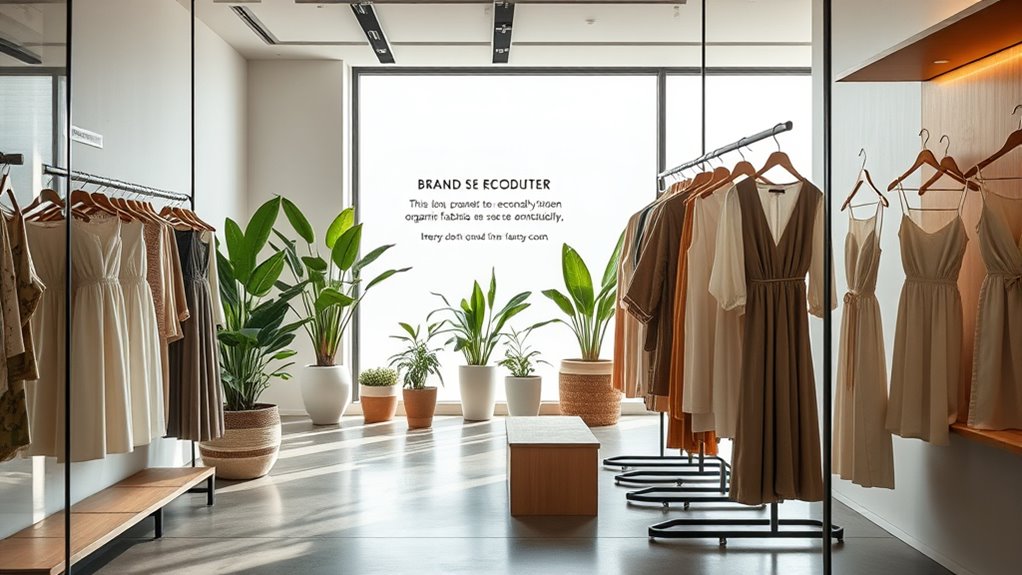
Luxury brands are setting ambitious long-term sustainability targets, like Gucci’s goal to cut its carbon footprint by over half by 2030. Many are also committing to emission reduction plans aligned with science-based standards, ensuring transparency and accountability. These commitments highlight a clear shift toward integrating sustainability deeply into their core strategies. Creative practice techniques can help brands develop innovative approaches to sustainability challenges, fostering more effective and resilient solutions. Additionally, implementing ethical hacking methods can assist in identifying vulnerabilities in their sustainability data systems, ensuring integrity and trustworthiness in reporting. Incorporating diverse designs from unique planters can also promote eco-friendly aesthetics and reinforce brands’ commitment to environmental responsibility. Emphasizing supply chain transparency further demonstrates their dedication to responsible sourcing and environmental impact reduction.
Long-Term Sustainability Targets
Have you ever wondered how high-end brands are shaping their future through sustainability? Luxury fashion brands set ambitious long-term sustainability targets to guarantee lasting impact. For example, Gucci aims to reduce its carbon footprint by 55% and achieve 95% raw materials traceability by 2030, while Hermès targets net-zero emissions by 2050. Brands like Burberry pursue climate positivity by 2040 through renewable energy use, responsible sourcing, and circular economy initiatives. These long-term goals emphasize transparency, with many adopting science-based targets (SBTi) to track progress. By integrating eco-friendly initiatives, circular practices, and renewable energy, these brands demonstrate their commitment to accountability and sustainable growth, ensuring their future aligns with environmental responsibility and responsible sourcing. Predictive modeling can further assist brands in forecasting environmental impacts and optimizing their sustainability strategies. Additionally, fostering active listening within corporate teams can enhance internal collaboration and drive innovative solutions for sustainability challenges.
Emission Reduction Commitments
Many brands in the fashion industry are actively committing to emission reduction targets that drive sustainable transformation. They aim to lower their carbon footprint and achieve net-zero emissions through bold sustainability commitments. Gucci plans to cut its direct carbon footprint by 55% by 2030, while Burberry targets a 90% reduction in Scope 3 emissions by the same year. Industry initiatives like The Fashion Pact unite over 160 brands to pursue greenhouse gas reductions, aiming for net-zero by 2050 and 50% renewable energy use by 2025. Chanel’s climate plan focuses on halving operational impacts and shifting to 100% renewable energy. Louis Vuitton and Hermès are also committed to emission reduction strategies, emphasizing sustainable materials, circularity, and innovative R&D to meet their climate targets. Additionally, integrating environmental innovations such as renewable energy and waste management solutions can further enhance the sustainability efforts within the industry.
Pioneering Leadership and Innovation in Sustainability

Leading the charge in sustainability requires bold innovation and unwavering commitment, as exemplified by industry pioneers who are redefining luxury fashion. These brands embrace sustainable innovation by developing eco-conscious luxury collections that prioritize circular fashion and ethical materials. You’ll see leaders like Stella McCartney pioneering plant-based leathers and avoiding animal-derived fabrics altogether, setting a high standard for eco-friendly practices. Gucci’s focus on a transparent supply chain and sustainable sourcing ensures material traceability of 95% of its raw materials, while Gabriela Hearst achieves a fully plastic-free operation with biodegradable, naturally sourced materials. Vivienne Westwood leads by example with over 90% recycled fabrics and lower-impact materials. Industry innovators like Acne Studios and Reformation demonstrate how circular design principles and recycled fabrics drive sustainable innovation in luxury fashion. Additionally, some brands are actively monitoring signs of spoilage and ensuring the freshness of their materials to uphold quality and sustainability standards, highlighting the importance of sustainable materials in eco-conscious production. The integration of innovative wicking materials and sustainable practices further demonstrates their commitment to minimizing environmental impact and promoting long-term ecological balance. A growing emphasis on ethical sourcing further underscores the commitment of these brands to comprehensive sustainability.
Material Advancements and Eco-Friendly Product Development
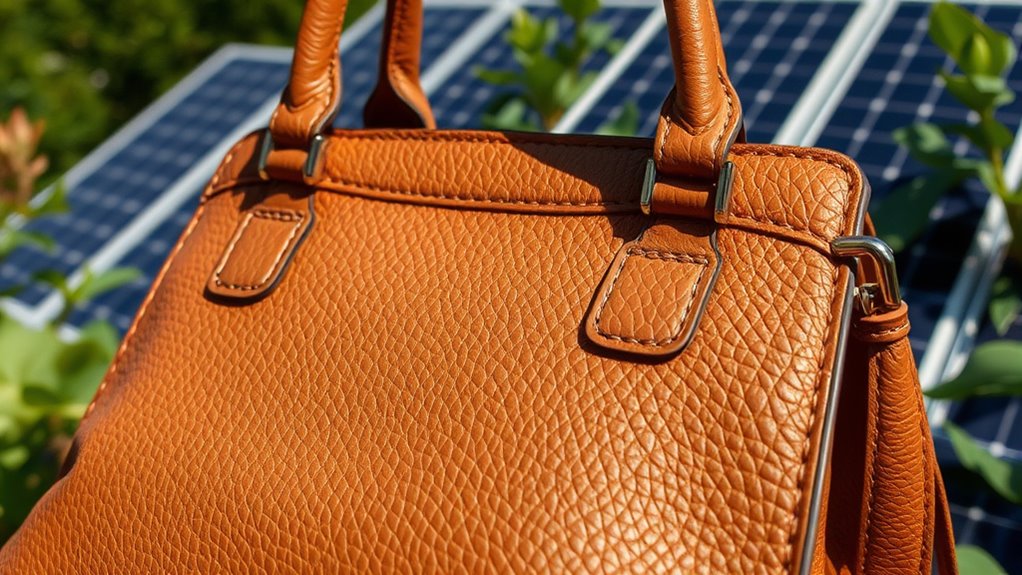
You can see how luxury brands are transforming their products through innovative sustainable materials like mushroom leather and recycled nylons. These advancements allow for designs that prioritize durability and timeless appeal, reducing waste over time. Embracing eco-friendly textiles paves the way for fashion that’s both luxurious and kind to the planet. Additionally, some brands are participating in internal company hackathons to develop new sustainable solutions and improve their eco-conscious practices. Exploring sustainable material innovations highlights how continuous research is driving the industry toward more environmentally responsible fashion. Moreover, the incorporation of best beaches as inspiration for natural patterns and textures is an emerging trend in sustainable design. Recognizing the importance of biodegradable textiles further underscores the industry’s commitment to reducing long-term environmental impact.
Innovative Sustainable Materials
Innovative sustainable materials are transforming luxury fashion by blending environmental responsibility with artisanal craftsmanship. Brands leverage alternative materials like Mylo, a mushroom leather, and biodegradable rubber to reduce ecological impact. Econyl, a regenerated polyamide, is repurposed from ocean plastic, turning marine waste into high-end textiles. Hermès partners with biotech startups to develop Mycelium Leather, an eco-friendly fabric from fungi. Gucci’s Off the Grid collection showcases recycled nylon and organic cotton, emphasizing recycled and natural fibers. Dior collaborates with Parley for the Oceans to incorporate ocean plastic into yarns, merging innovation with luxury. Key materials include:
- Mylo and Mycelium Leather
- Econyl and recycled nylon
- Biodegradable rubber
- Eco-friendly fabrics and regenerated polyamide
Additionally, the integration of natural materials like linen and organic cotton further emphasizes a commitment to sustainability without compromising luxury. Incorporating sustainable manufacturing practices also plays a crucial role in reducing environmental impact throughout the supply chain, including innovative dyeing techniques that minimize water and chemical use. The use of alternate materials helps brands meet the growing consumer demand for eco-conscious fashion.
Recycled and Regenerative Textiles
Recycled and regenerative textiles are transforming luxury fashion by turning waste into high-end materials. Brands are increasingly adopting eco-friendly materials like recycled textiles, such as Gucci’s ECONYL regenerated nylon and Prada’s Re-Nylon, which uses over 90% recycled nylon. Hermès introduces Mycelium Leather, a regenerative textile from mushroom mycelium, highlighting innovation in sustainable fabrics. Bio-based materials like Piñatex, made from pineapple leaf fiber, and plant-based leathers from Stella McCartney reduce reliance on animal and synthetic sources. Parley for the Oceans collaborates with brands like Dior to create yarns from ocean plastic, repurposing marine debris into high-performance, eco-friendly textiles. These efforts focus on biodegradable textiles and nylon regeneration, driving the industry toward a circular, waste-free future. Incorporating vibrational energy principles from the Law of Attraction, brands are also emphasizing the importance of aligning with environmental consciousness to attract sustainable success.
Designs Emphasizing Longevity
Designs emphasizing longevity are reshaping luxury fashion by focusing on materials and styles that stand the test of time. You’ll notice brands like Stella McCartney and Hermès pioneering eco-conscious fabrics such as mushroom leather and mycelium-based products to extend product lifespan and reduce environmental impact. Collections often feature classic styles and versatile pieces crafted with durable materials and high-quality craftsmanship, ensuring long-term wear. Key strategies include:
- Use of eco-friendly textiles like regenerated nylon, organic cotton, and recycled linen
- Adoption of timeless design to minimize the need for frequent replacement
- Emphasis on responsible sourcing, repair, and upcycling practices
- Creating durable products that maintain appeal and functionality over years
This approach champions longevity, helping you invest in pieces that blend style with sustainability for the long haul.
Notable Sustainable Fashion Labels and Brands

Several luxury fashion labels are leading the way in sustainability by integrating eco-friendly practices into their collections. These sustainable luxury fashion brands prioritize eco-friendly materials, such as recycled fabrics, biodegradable textiles, and animal-free materials like mushroom leather. They emphasize ethical sourcing and supply chain traceability to guarantee transparency and reduce environmental impact. Brands like Stella McCartney avoid animal-derived materials altogether, focusing on innovative solutions like recycled nylon. Gucci commits to 95% traceability of raw materials and uses organic cotton, recycled steel, and ECONYL regenerated fibers. Gabriela Hearst incorporates upcycled designs and biodegradable plastics, while Vivienne Westwood promotes slow fashion with organic cotton and recycled metals. Acne Studios enhances sustainability through transparent reporting and durable, eco-conscious collections.
Strategies for Consumers to Support Sustainable Luxury
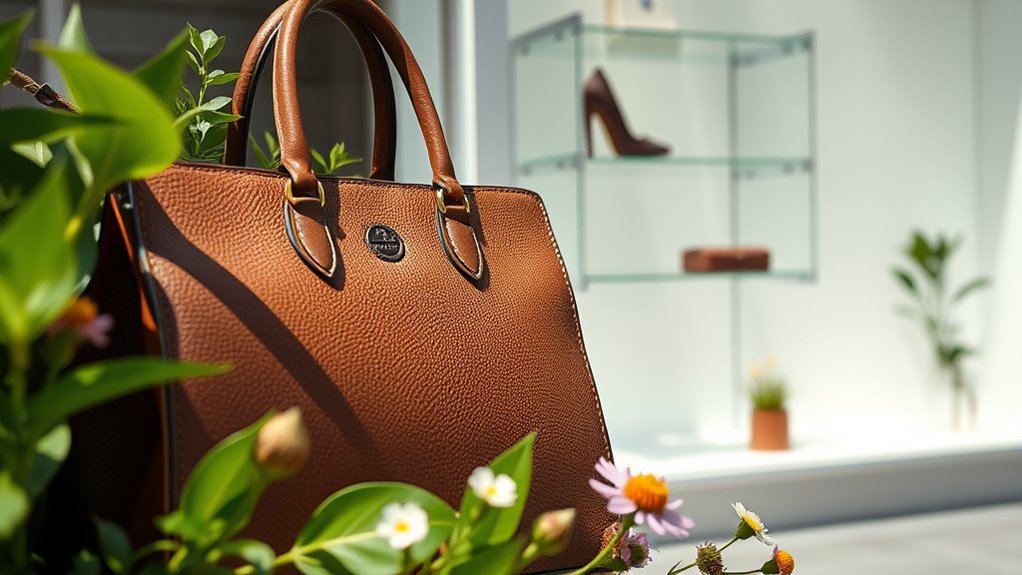
To effectively support sustainable luxury, you should start by researching brands’ sustainability credentials and certifications, such as B-Corp or SBTi, to guarantee they genuinely prioritize eco-friendly practices. Your responsible consumption can be amplified by focusing on high-quality, durable pieces designed for longevity, which helps reduce waste. Support brands that are transparent about their supply chains and use recycled or responsibly sourced materials, like Gucci’s ECONYL or Stella McCartney’s vegan leathers. Additionally, practice mindful shopping by avoiding fast fashion traps and opting for timeless designs that can be worn for years. You can also extend the life of your luxury items through:
Prioritize sustainable brands, invest in durable pieces, and practice mindful shopping to support eco-friendly luxury.
- Clothing rentals and secondhand shopping
- Proper garment care
- Choosing eco-conscious materials
- Supporting brands committed to transparency
Frequently Asked Questions
What Are Luxury Brands Doing for Sustainability?
You might wonder what luxury brands are doing about sustainability. They’re making significant changes by setting science-based targets, switching to renewable energy, and sourcing eco-friendly materials. They’re also eliminating exotic and animal-derived products, replacing them with innovative alternatives like mushroom leather and recycled fabrics. Transparency is key, so they’re tracking raw materials and ensuring ethical supply chains. Many are launching sustainable collections and collaborating industry-wide to reduce emissions and promote eco-conscious practices.
Which Luxury Brand Is Most Sustainable?
You’re wondering which luxury brand leads in sustainability. Stella McCartney stands out as the most sustainable, since she’s been pioneering cruelty-free materials and substantially reducing environmental impact since 2001. Her innovative approach, transparency, and eco-conscious practices set her apart. While other brands like Gucci and Hermès are making notable progress, Stella’s long-term commitment and leadership in sustainable luxury make her the top choice for eco-minded consumers.
What Is Gucci Doing to Be Sustainable?
You’re wondering what Gucci is doing to be sustainable. Gucci commits to sourcing 95% of its raw materials with full traceability and avoids animal fur and exotic skins. They’ve launched the “Gucci Off the Grid” collection with eco-friendly materials, follow policies to prevent deforestation, and aim for 100% carbon neutrality by investing in renewable energy. They also partner with organizations like Parley for the Oceans to promote marine conservation.
What Are Designers Currently Using to Be Sustainable in the Fashion Industry?
You see, designers are now using innovative, eco-friendly materials like organic cotton, recycled nylon, Mycelium leather, and Piñatex pineapple fibers. They’re also incorporating deadstock fabrics and upcycled textiles to cut waste. Plus, they’re collaborating with biotech startups to develop plant-based and biodegradable synthetics. Natural dyes, water-saving techniques, and energy-efficient processes also play a big role, helping you enjoy fashion that’s stylish and better for the planet.
Conclusion
By supporting sustainable luxury brands, you help drive real change—did you know that the fashion industry accounts for about 10% of global carbon emissions? Every purchase you make can contribute to a greener future, encouraging brands to innovate with eco-friendly materials and transparent practices. Your choices matter more than ever in shaping a more sustainable, stylish world. So, stay informed, choose wisely, and be part of the movement toward responsible luxury fashion.
